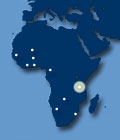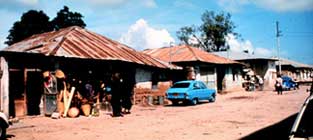|
||||||||||||
| Burkina Faso | Cameroon | Cote D’Ivoire | Ghana | Mali | Namibia | Senegal | Swaziland | Tanzania | Zambia | ||||||||||||
Information Source: Tanzania: Country Assessment Report. |
||||||||||||
|
||||||||||||
|
Context Summary Tanzania is approximately 945,100 sq. km. with a population of approximately 31 million, at a density of 32 persons per square kilometer. Agriculture accounts for 60 percent of the Gross Domestic Product (GDP), followed by services (26 percent) and industry (15 percent). It has a GDP per capita of approximately US$220 (1997). Its diverse habitats and climate have enabled Tanzania to build a successful tourist industry around its wildlife. 25 percent live in urban areas growing at over 6 percent per annum, around twice the national rate of population growth. There are ten major towns with populations of over 150,000 with the major city and port, Dar es Salaam, having a population of approximately three million. Tanzania’s rural-to-urban migration is a result of the decline of international primary commodity prices (mainly from coffee and sisal) in the 1970s and 1980s and other disincentives to national farmers that helped push rural producers to the towns in search of employment. Dar es Salaam is seven times the size of the next largest city, Mwanza, and is growing at 8% per annum. It is estimated that about 70 percent of Dar es Salaam’s population live in poor, unplanned settlements, characterized by lack of basic infrastructure and ever-increasing poverty. It has been estimated that 50 percent of the informal settlement population lives on an average income of about US$1 per day. In the 1960s, slum clearance was the common approach, with high-standard buildings developed on the cleared sites. The policy was implemented through the National Housing Corporation, but by the end of the 1960s it was abandoned due to high economic and social costs, and with negligible additions to the housing stock. Until the late 1980s, sites and services and squatter upgrading projects formed the national strategy, with the World Bank initially supporting these projects. However, the World Bank ceased support after its second project because of poor performance. In 1992, UNCHS (Habitat) introduced the 'Environmental Planning and Management' approach, and the Hanna Nassif Community-Based Upgrading Project was initiated through the 'Sustainable Dar es Salaam Project' (SDP), with support from the International Labor Organization (ILO) and the Ford Foundation. Subsequently the SDP collaborated with the World Bank on the preparation of further upgrading programs. However, delays resulted in a recasting of the Community Infrastructure Program (CIP) and ultimately only two communities were upgraded. Early projects tried to address housing and housing related issues for the urban poor following a largely multi-sectorial and participatory approach, while the Hanna Nassif Upgrading Program focused mainly on drainage. Recent projects continued with the multi-sectorial approach. Lessons from Recent Projects - Summary Key lessons from Hanna Nassif Community Based Upgrading Project - Phase 1
Key lessons from Hanna Nassif - Phase 2
|
||||||||||||
|
|
||||||||||||
| For more information: Click on: Foreword 1. Background 2. Current Situation 3. Policy Context and Institutional Framework 4. Upgrading Projects and Programs 5. Case Study 6. Lessons Learned 7. Challenges and Proposed Next Steps Annex A. Contact Information Annex B. Bibliography-Key Documents Studied Annex C. Country and City Basic Data Annex D. Unplanned Unserviced Settlements in Dar es Salaam Annex E. Planned Unserviced Settlements in Dar es Salaam Annex F. Summary of Upgrading Typologies Download for Printing: |
||||||||||||
| < Return to top > | ||||||||||||
|
||||||||||||


